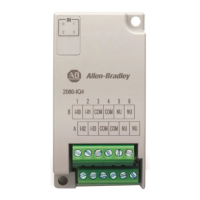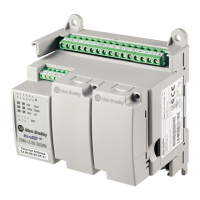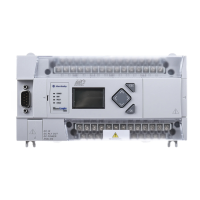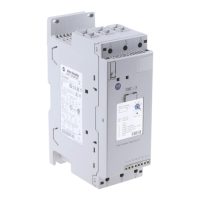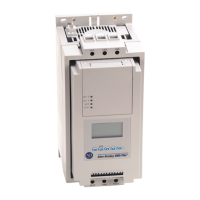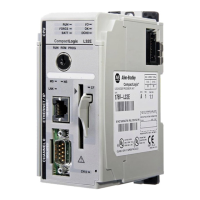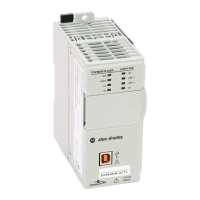Rockwell Automation Publication 2080-UM002N-EN-E - November 2022 345
Appendix G Connect to Networks using DF1
Polling Mode
If you want to:
• accept unsolicited messages from slave stations, choose MESSAGE BASED (ALLOW SLAVES
TO INITIATE MESSAGES)
Slave station-initiated messages are acknowledged and processed after all master
station-initiated (solicited) messages.
Note: Slave stations can only send messages when they are polled. If the message-based
master station never sends a slave station a message, the master station will never send
the slave station a poll. Therefore, to regularly obtain a slave station-initiated message
from a slave station, you should choose to use standard communication mode instead.
• ignore unsolicited messages from slave stations, choose MESSAGE BASED (DO NOT ALLOW
SLAVES TO INITIATE MESSAGES)
Slave station-initiated messages are acknowledged and discarded. The master station
acknowledges the slave station-initiated message so that the slave station removes the
message from its transmit queue, which allows the next packet slated for transmission
into the transmit queue.
Duplicate Packet
Detect
Duplicate Detect lets the controller detect if it has received a message that is a duplicate of
its most recent message from another station. If you choose duplicate detect, the controller
will acknowledge (ACK) the message but will not act on it since it has already performed the
message’s task when it received the command from the first message.
If you want to detect duplicate packets and discard them, check this parameter. If you want
to accept duplicate packets and execute them, leave this parameter unchecked.
Reply Message Wait
Timeout
Defines the amount of time, in 20 millisecond increments, that the master station will wait
after receiving an ACK (to a master-initiated message) before polling the slave station for a
reply.
Choose a time that is, at minimum, equal to the longest time that a slave station needs to
format a reply packet. This would typically be the maximum scan time of the slave station.
ACK Timeout
The amount of time, in 20 millisecond increments, that you want the controller to wait for an
acknowledgment to the message it has sent before the controller retries the message or the
message errors out. This timeout value is also used for the poll response timeout. See
See Minimum DF1 Half-Duplex Master ACK Timeout
on page 342 for recommendations to
minimize this value.
RTS Off Delay
Defines the amount of time, in 20 millisecond increments, that elapses between the end of
the message transmission and the de-assertion of the RTS signal. This time delay is a buffer
to make sure that the modem has transmitted the message but should normally be left at
zero. See RTS Send Delay and RTS Off Delay
on page 339 for further guidelines for setting
this parameter.
RTS Send Delay
Defines the amount of time, in 20 millisecond increments, that elapses between the
assertion of the RTS signal and the beginning of the message transmission. This time allows
the modem to prepare to transmit the message. The Clear-to-Send (CTS) signal must be
high for transmission to occur. See RTS Send Delay and RTS Off Delay
on page 339 for
further guidelines for setting this parameter.
Pre-Transmit Delay
Defines the amount of time, in 1 millisecond increments, that elapses between when the
controller has a message to send and when it asserts the RTS signal.
Message Retries
Defines the number of times a master station retries a message before it declares the
message undeliverable.
IMPORTANT The unconnected timeout value in the Message instruction should
always be larger than the pre-transmit delay.
Table 95 - Configure a Micro800 Controller as a Master Using Message-based
Communication Mode (Continued)
Parameter Selections

